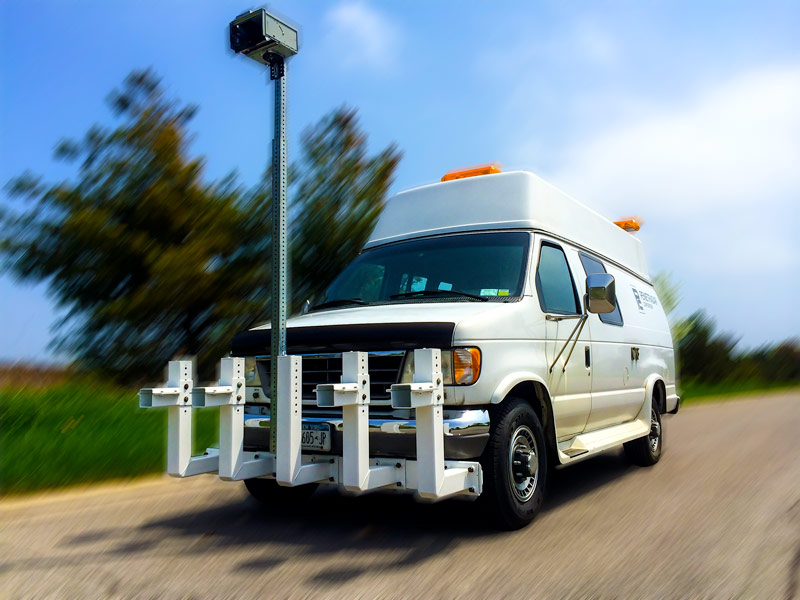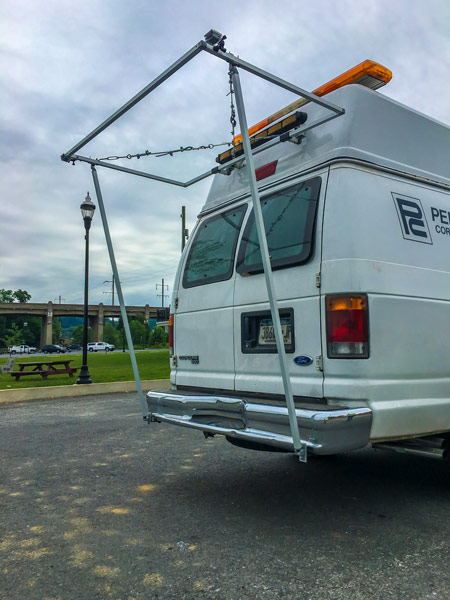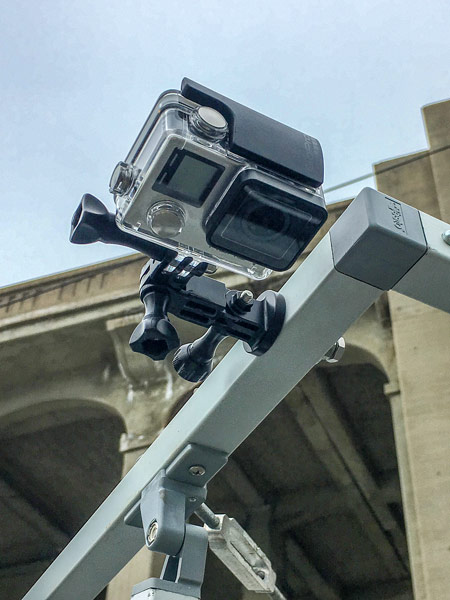BRIDGE DECK INSPECTION

Penetradar Technical Services can assist you with bridge deck delamination and deterioration surveys on asphalt covered and exposed concrete bridge decks using ground penetrating radar and infrared thermography. These technologies can provide quantitative information on the location and quantity of deteriorated concrete and corrosion induced delaminations. In addition, ground penetrating radar (GPR) can measure the depth of reinforcing steel and thickness or bond of overlays. Our GPR and Infrared bridge deck surveys are conducted at highway speeds and require no traffic control, thereby eliminating traffic interruptions. Ground Penetrating Radar and Infrared Thermography are cost effective sources of quantitative information for bridge and maintenance engineers, that can be used for determining repair quantities and preparing project cost estimates, or for high speed inspection of bridge deck networks.
Non-Destructive Testing Methods
The three non-destructive testing methods below can be used individually or together in the inspection of bridge decks. Using multiple methods together can increase the reliability of the results by detecting anomalies in the bridge deck through the use of different technologies. Penetradar has found that using all three methods provides a more complete inspection of the bridge deck and can provide a complete mapping of these results including a visual plan-view of the bridge deck surface. More information on how each of these technologies are used in the inspection of bridge deck and examples of what is provided in the report can be found by clicking on their respective buttons.
Ground Penetrating Radar (GPR)
High Speed Bridge Deck Surveys
Penetradar Technical Services Group provides nondestructive inspection of bridge decks using state-of-the-art IRIS ground penetrating radar. GPR is a non-contacting and non-intrusive means of determining the condition of asphalt covered and exposed concrete bridge decks. GPR deck surveys can be used throughout the year and are relatively weather insensitive.
GPR deck surveys are conducted at highway speeds using multiple non-contacting antennas. Linear antenna scans are processed and combined to produce a plan view mapping of the bridge deck showing the size and shape of the delamination and deteriorated area. Topographical profile mapping of rebar depth or asphalt thickness is also produced. Penetradar’s GPR results are provided in an easily understood and usable graphical output format.

Standard IRIS Vehicle with four antennas installed
GPR Bridge Deck Capabilities
Detect Delaminations
Detect Deteriorated Concrete
Measure Depth of Reinforcement
Measure Thickness of Overlays
Detect Debonded Overlays
GPR Data Collection
GPR data are collected in a series of longitudinal scans along the length of the bridge deck, at high speed and without traffic interruption. Multiple antennas (antenna array) are used to cover an entire lane for one-pass inspection. Our IRIS GPR antenna array ensures that all antenna scans are properly correlated and that detections are properly identified in location and size. GPR can be used effectively on exposed concrete or overlaid bridge decks.
GPR Data Analysis
GPR data are analyzed to detect corrosion induced delamination located at the reinforcing steel, scaled (freeze-thaw damaged) concrete, debonded overlays, depth of reinforcing steel and overlay thickness.
Results - Deliverables
Fully analyzed results are provided in CAD form as plan-view deck maps showing the location and extent of delamination and deterioration, or depth of reinforcement and overlay thickness. Depth of reinforcement and overlay thickness are also shown as numerical listings or in ASCII file format.
GPR Standards
GPR data are analyzed in accordance with AASHTO TP-36, SHRP C-101 and ASTM D6087-03/08.

Example output map showing detected delaminations
Infrared Thermography (IRT)
High Speed Bridge Deck Surveys
Penetradar Technical Services Group also provides infrared thermographic inspection of bridge decks with a vehicle based system that utilizes an advanced, high resolution thermographic camera and incorporates leading-edge computer based video data acquisition and image processing hardware and software, which results in improved detection rates and accuracy in the location and size of deteriorated concrete areas.

Penetradar's ThermaMap System
IRT Bridge Deck Capabilities
Detect Delaminations
Detect Deteriorated Concrete
Detect Debonded Overlays
IRT Data Collection
Infrared Thermographic data are collected, utilizing a high resolution, forward looking, infrared thermographic camera. The camera's wide angle lens allows for full lane infrared capture on the bridge deck, so only one pass is needed per lane. Also the infrared camera records radiometric data, meaning temperature values are embedded into the data. This is important for post-processing by producing optimal temperature ranges for detailed data analysis.
Due to the nature of the heating/cooling cycles in the bridge deck, for delamination detection, the optimal times for infrared data collection are during the morning/early afternoon hours (10:00AM - 12:30PM) or during the evening/night hours for a 3-4 hour window after sunset.
IRT Data Analysis
Infrared Thermographic data are analyzed using specialized software developed for analysis of IRT data. The software is used to detect regions of concrete that exhibited statistically higher temperatures (for daytime collected data) or lower temperatures (for nighttime collected data) relative to the surrounding concrete temperature. These regions of temperature difference usually correspond to locations of deteriorated/delaminated/debonded concrete. Video Imaging is used with Infrared Thermography to help increase the reliability of these locations been labeled as delaminations.
Results - Deliverables
Penetradar’s cutting-edge analysis software produces accurately scaled, plan-view (top-down perspective) thermal maps showing delaminations based upon distance. Our software preserves of the size, dimensions and location of thermal anomalies such as delamination, debonding or other flaws. This process removes much of the subjectivity and errors that are inherent with older, manual analysis methods.
IRT Standards
Infrared Thermographic data are analyzed in accordance with ASTM D4788 - 03.

Output Infrared Map showing areas of probable delamination (red areas)
High Resolution Imaging (HRI)
High Speed Bridge Deck Surveys
Visual Inspection of bridge decks is typically performed to identify areas of distress. An inspection of the deck can both provide information on the condition of the concrete in localized areas and also provide an overall indication of the general condition of the bridge deck. Penetradar uses a high resolution camera to record this visual inspection.
A new method, developed by Penetradar Corporation, utilizes a vehicle based video mapping system and specialized software that converts the high resolution video into “plan-view” images. The new software, the function of which is analogous to a line-scan recorder, takes individual portions of each video image to recreate a top-view (or plan-view) image of the bridge deck. In this way, deck dimensions, the locations and size of detections are accurately preserved and in addition, this new method reduces time on-site and minimizes the requirement for lane closures.
The use of this wide-angle high-resolution video camera not only can record in detail areas of interest such as patching and spalls, but it is an invaluable assistant to the use of Infrared Thermography and is helpful to Ground Penetradar Radar. The video recording help with assuring that potential detections found by the infrared camera are just that and not something in the road or a surface feature. These seem obvious, but as not as such with just the use of the infrared camera.
This is why it is recommended to use the video camera along with the other technologies for inspection. Even though GPR uses waveforms for detecting areas of interest, a video recording of the bridge can prove to be very useful for referencing. The final processed plan-view visual map of the bridge deck surface may be used along with the other created maps to create a complete inspection map of the bridge with detections overlaid on top of the bridge deck's current representation with detailed features preserved.

Video recordings are captured at an ultra-high resolution (4K) of up to 3840x2160 at 60 fps.

Ensuring that all details of the bridge deck and pavement surfaces are recorded with maximum quality at highway speeds.
HRI Bridge Deck Capabilities
Visual Plan-View Maps of Deck Surface showing detailed surface conditions including cracks, spalls, patches
(assists GPR & IRT in)
Detect Delaminations
Concrete Deterioration
Void Beneath Pavements
Image Capture
Video imaging is collected in the daylight hours to ensure proper lighting in the video, to detect areas of importance in the bridge deck. The camera is synchronized with the vehicle's distance measuring instrument (DMI) to relate the distance traveled with the video. The high resolution and frame rate of the camera, along with the precise pulse rate (less than one inch per pulse) of the DMI allow of accurate high speed video recording and data collection. Possessing a wide angle lens, the camera can capture multiple lanes from a centralized vehicle pass across the bridge; reducing scanning time.
Image Analysis & Post-Processing
The captured video of the bridge deck is put through Penetradar's software specifically designed for removing the oblique perspective of the video and converting it into a correctly scaled top-down view (plan-view) map. This software takes the frames from the video and basically pulls out the correct number of lines corresponding to the distance embedded in the file from the dmi. The lines from the frames are then compiled together to create a full length top-down map of the bridge deck preserving the dimensions of all the surface details.
Results - Deliverables
The software processed video creates a visual plan-view maps of the bridge deck surface. The high-resolution of the camera allows this map to shown with great detail any areas of importance such as spalls, patches and cracks. This can be easily identified on the map.
This visual plan-view map can be used in a combination with ground penetrating radar and infrared thermographic produced maps as layers to produce a complete interactive map that allows for different layers of detections and maps to be viewed with any combination. This complete map eliminates the need to view separate maps to compare detection types. The addition of the high resolution visual map layer further enhances the output map adding the ability to see the detections from the GPR and IR maps on the actual surface of the bridge deck. This helps in visualizing there detections/anomalies are located on the bridge deck (relative to any surface feature such as joints, spalls, patches).

Visual Plan-View map of bridge deck showing patches, marked out locations and other surface features. The zoomed in section shows the detail that the camera picked up by showing the dimensions and contours of the patches.

